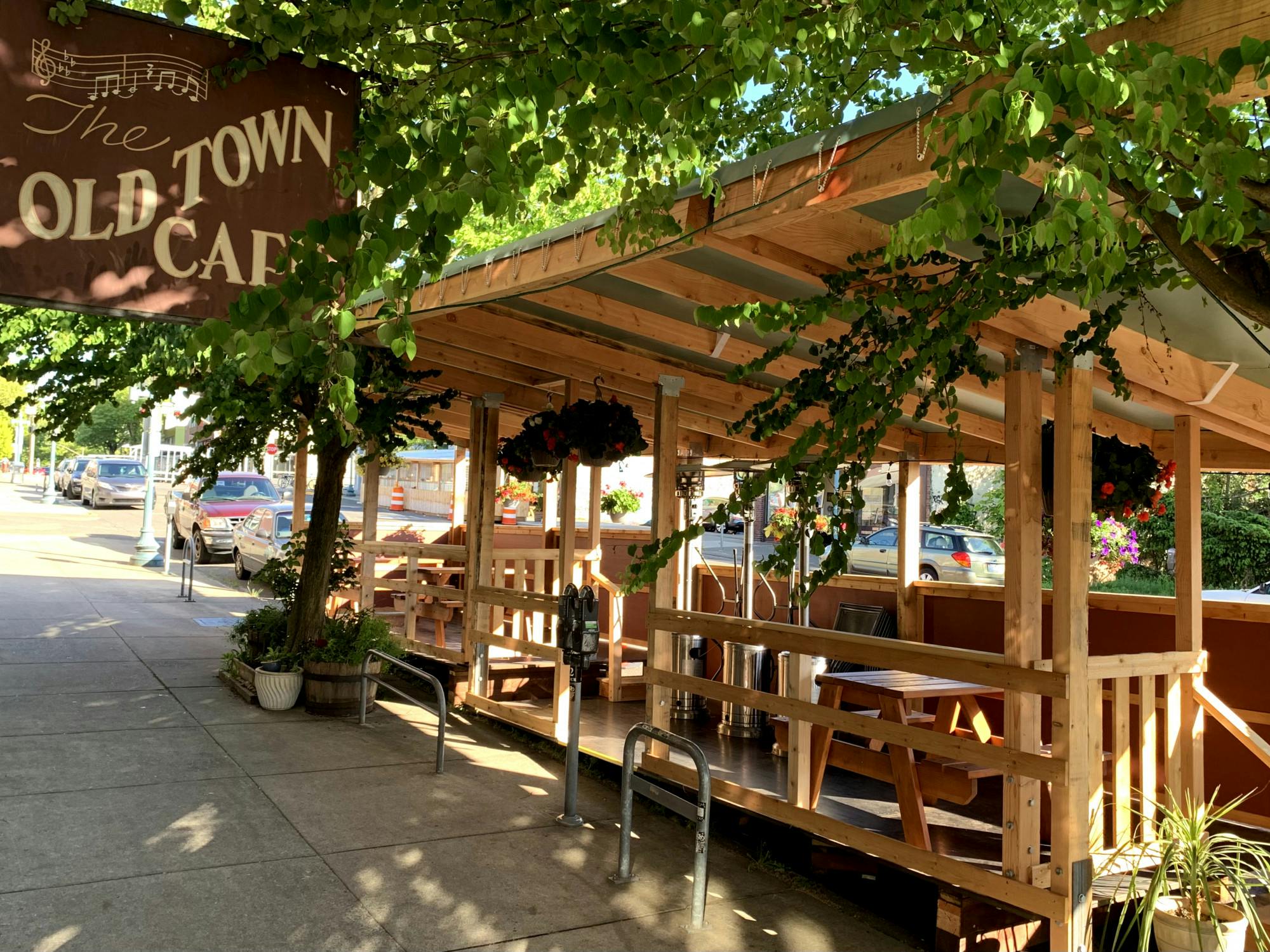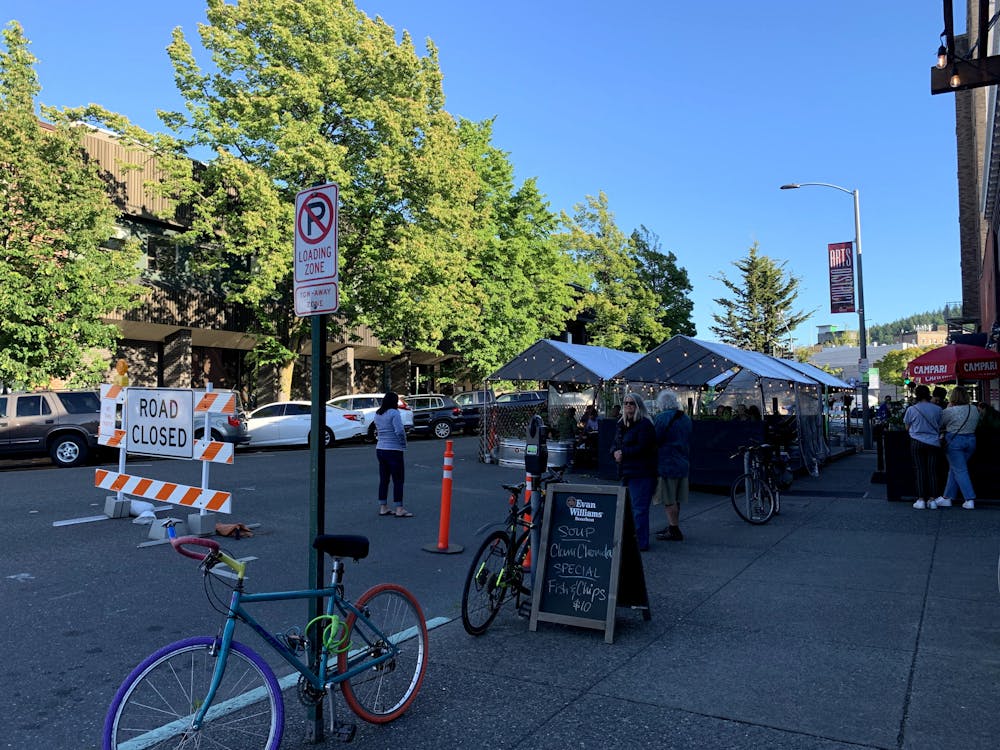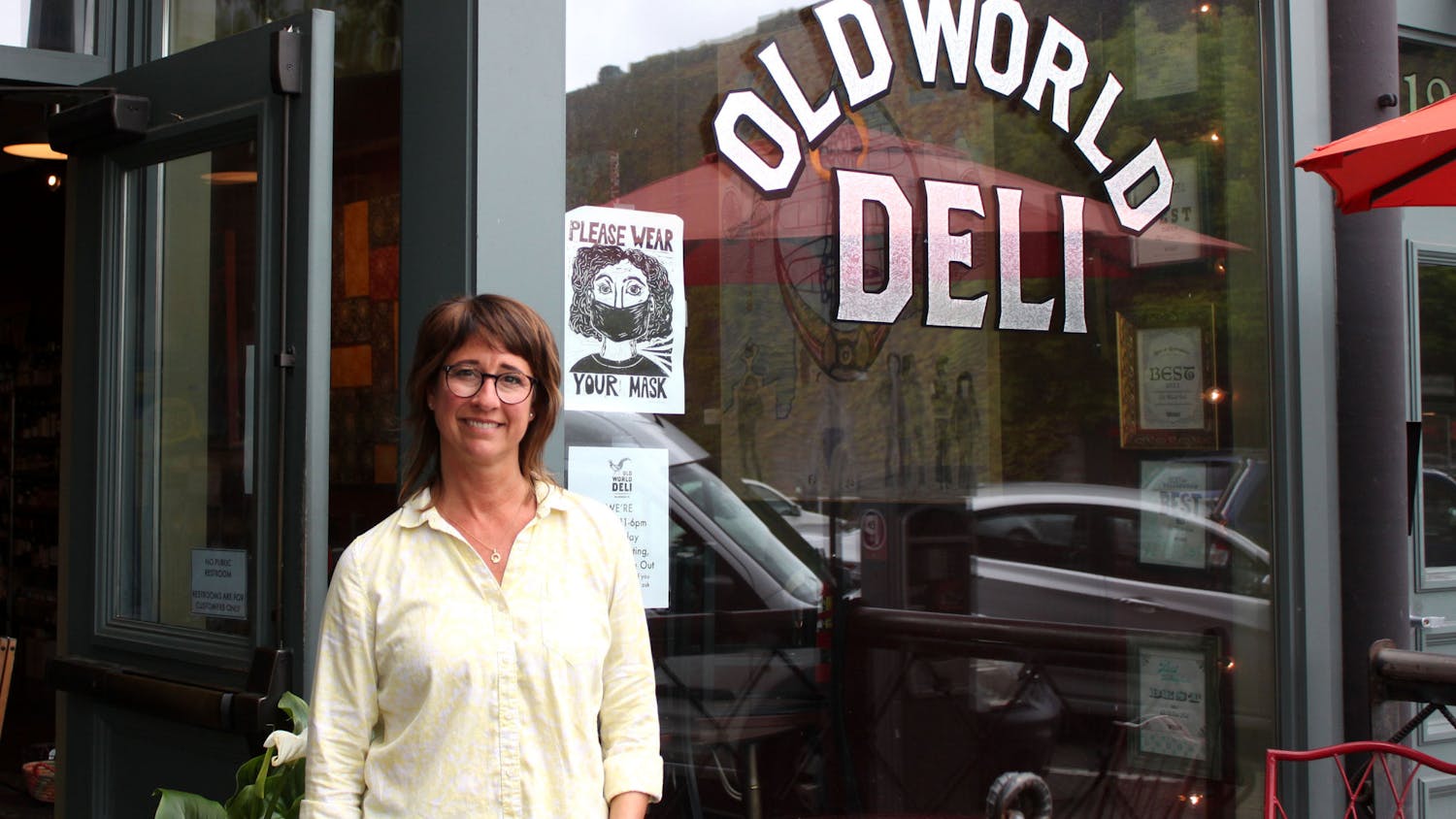The 100 block of Grand Avenue has been without a southbound lane since last August. The reason? Upscale Italian food and hard cider.
The owners of two businesses located on Grand, Storia Cucina and Thousand Acre Cider House, are advocating to secure their outdoor patio spaces into the future, even after COVID-19 restrictions are lifted. The outdoor spaces currently block off the entirety of the southbound lane of Grant Avenue’s 100 block.
Grand Avenue is among many roads in Bellingham that have been altered to accommodate businesses who apply for the city’s outdoor seating program. The city allows restaurants, bars, cafes and other businesses to apply and pay for permits that allow the construction of outdoor seating parklets — small structures that take over sidewalks, parking spaces or street lanes.
In April, Jenny Hagemann, owner of Thousand Acre Cider House, and Jonathan Cicotti, owner and head chef at Storia Cucina, asked the public for signatures on a petition to the city of Bellingham to allow the two businesses to permanently keep the patio seating around.
Hagemann said that outdoor seating was one of the only reasons her business, which was less than a year old at the beginning of the COVID-19 pandemic, was able to survive. She described the patio on Grand Avenue as “a lifeboat.”
Storia Cucina opened in the midst of the pandemic last May. Cicotti said that having the outdoor parklet structure in the street allowed the business to get by using more than just a to-go avenue of sales during their first year.
“Once outdoor dining happened, people felt safe dining outside,” Cicotti said. “So they were just like, ‘Okay, we have like our little taste of restaurants back.’”
According to Hagemann, those who responded to the petition were overwhelmingly supportive of the move to keep the two patios around, and the city granted their request through the end of this year.
Bellingham’s outdoor seating program began before the COVID-19 pandemic, said Darby Cowles, a senior city planner for the City of Bellingham. This meant when the pandemic arrived, there was already an outline for the process that business owners would need to go through to clear their structures with the city.
Cowles said the program wasn’t very popular with businesses before the pandemic. Now, parklets and patio seating structures have popped up all across the city.
Lindsay Payne Johnstone, program director at the Downtown Bellingham Partnership, was tasked with helping downtown businesses through permit applications and supporting them in their building process.
“We've had so many businesses report that they wouldn't have gotten through winter without the outdoor expansion of their business footprint,” Johnstone said.
Other businesses outside of Grand Avenue, like Old Town Cafe, have invested in keeping their outdoor seating around by building more permanent infrastructure.
Old Town Cafe’s owner, Diane Brainard, said that the decision to build their patio more permanently was made with the safety of customers in mind, as well as concerns about the sturdiness of any structure that stood the test of the strong winds on Holly Street. RAM Construction built Old Town Cafe’s patio structure, which Brainard said was affordable because the company only charged the restaurant the cost of the materials.

“We had to build something kind of sturdy and plus, because of the traffic, we wanted something safer for people,” Brainard said.
Currently, streets like Grand Avenue and the patio structures within them are surrounded by orange traffic barricades and road closure signs. Cowles said that Bellingham’s Planning and Community Development Department will collaborate with the city’s Public Works Department to oversee a transition into more permanent traffic infrastructure surrounding the structures.
“The city will be doing some work to make it look a little bit more permanent because right now there’s like, a bunch of construction cones and concrete barriers, and it looks, like, a little janky,” Cowles said. “So we’re going to invest.”
Many of the outdoor parklet structures in Bellingham encroach onto public street parking, making it more difficult for drivers to find convenient spots to park. The idea of keeping these structures around permanently plays into the concept of human-centered urban design, which prioritizes planning for pedestrians over cars and other large vehicles.
“People drive cars because it's the easiest thing to do to get around,” said Chris Van Aken, a city planner based out of Payson, Utah. “If there's an option where it's easier and faster to get around without a vehicle, you know, whether it's public transit or walking, I think people just have to have that incentivized for them.”
Van Aken said cities like Bellingham could transition to have more human-centered design elements if governments invest in accessibility and infrastructure.
“I think it can absolutely be done,” Van Aken said. “I think Bellingham is in a great position to do so because you've got a lot of natural beauty in the area; you have a lot of tactile experiences built into walking around downtown Bellingham.”
Fairhaven is also home to many businesses that have introduced outdoor seating areas. Scott Ward, the executive director of the Fairhaven Association, said that parking complaints are among the top issues that arise when structures like parklets take over parking spaces.
“Every time we get something like this happening, [parking] becomes the hot topic,” Ward said. “I think that I really want to have people think about what it means to either bike into the village or walk into the village. My partner and I, we live a mile away from the village. It's a 15-minute walk for us and it’s a beautiful walk.”
Another example of a human-centered design move has been the removal of the left turn lane on West Holly Street’s 200 block. The lane was removed and replaced by outdoor structures built by businesses like Camber, Black Sheep and Jack’s.

Cowles said that after the Holly Street ‘restaurant row’ was introduced, the city’s traffic department determined that the lane wasn’t necessary to the flow of traffic moving forward. The restaurant row will now exist into the future, with no plans to re-open the turn lane.
“As long as they want to continue and renew their permit, they can be there,” Cowles said.
Ahnna Kesterson, a Bellingham resident, said that while she thinks many of the parklet seating areas are well-curated and comfortable, she is reluctant to support them in the long term, given they are privately-run.
“That's public space, you know? Those parking spots and things like that,” Kesterson said. “I think it would be fine to reallocate public space for a different public use, just not for private business use.”
Kesterson said that the division of space between each business causes confusion and discomfort for some who feel as though they can’t move freely between each business’ parklet. She recently observed patrons getting sunburnt at an uncovered parklet, and they felt wary about shifting over a few feet to a covered area that was run by a different business.
“There's going to be dynamic needs for these spaces that aren't going to be fulfilled on a business by business basis but could be fulfilled for the public,” Kesterson said.
Cowles said the city is invested in keeping outdoor parklets around. However, she said now that Bellingham businesses are emerging from the emergency response of last year, the city is hoping to take a more comprehensive approach to outdoor public infrastructure.
“We're going to be doing some outreach and workshops this year to look at, if we do close or convert streets, where is the most appropriate location,” Cowles said. “And to identify the best place instead of just making it based on which business applied during the emergency.”
Betty W. McNeely, a Bellingham resident who regularly visits restaurants around the city, said that she likes the idea of turning city streets into pedestrian-only zones. McNeely said she envisions a large public area with a roof covering one of the downtown streets, which could protect visitors from the rain and sun.
“As long as there's some kind of access to great parking, that would be a big draw, you know?” McNeely said.
Johnstone said the Downtown Bellingham Partnership will also be working closely with the city this year with planning, which she said could lead to a more permanent public outdoor plaza or town square area within downtown.
“We're at really preliminary stages,” Johnstone said. “But we understand that there is a need for that in our community and in downtown. And we're excited to kind of put a plan together to see what that could look like.”
For Hagemann, keeping an outdoor presence downtown isn’t just about keeping her business afloat — she thinks it can enhance Bellingham as a whole.
“I feel very passionate about the fact that the city of Bellingham can use this moment in history to take a stance away from ‘subdued’ as an element of our culture,” Hagemann said. “[We can] be big and bold and establish Bellingham as a destination for dining and vibing and shopping outdoors.”





